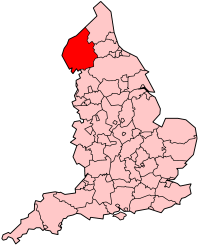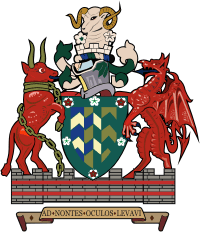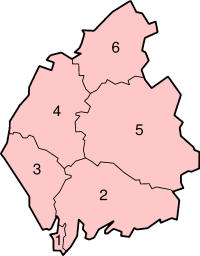Cumbria
 |
|
| Geography | |
|---|---|
| County Town (Admin HQ) |
Carlisle |
| Status | Ceremonial & Non-metropolitan county |
| Origin | 1974 Local Government Act 1972 |
| Region | North West England |
| Area - Total - Admin. council |
Ranked 3rd 6,768 km² Ranked 2nd |
| Neighbouring Counties |
Lancashire North Yorkshire County Durham Northumberland Dumfries and Galloway Borders |
| ISO 3166-2 | GB-CMA |
| ONS code | 16 |
| NUTS 3 | UKD11/12 |
| Demographics | |
| Population - Total (2007 est.) - Density - Admin. Council |
Ranked 41st 497,000 73 / km² Ranked 28th |
| Ethnicity |
96.7% White British 1.7% White Other 0.6% S.Asian 0.5% Mixed Race 0.2% Chinese 0.2% Afro-Carib. 0.1% Other |
| Politics | |
 Cumbria County Council http://www.cumbria.gov.uk/ |
|
| Executive | Conservative / Liberal Democrat |
| Members of Parliament | |
| Districts | |

|
|
Cumbria (IPA: /ˈkʌmbriə/) is a shire county in the extreme North West of England. Cumbria came into existence as a county in 1974 after the passage of the Local Government Act 1972. The county consists of six districts, and has a total population of 498,800.
Cumbria, the third largest ceremonial county in England, is bounded to the west by the Irish Sea, to the south by Lancashire, to the southeast by North Yorkshire, and to the east by County Durham and Northumberland. Scotland lies directly to the north.
A predominantly rural county, Cumbria is home to the Lake District National Park, considered one of the most beautiful areas of the United Kingdom. The area has provided inspiration for generations of British and foreign artists, writers and musicians. Much of the county is mountainous, with the highest point of the county (and of England) being Scafell Pike at 978 m (3210 ft). All the territory in England that is over 3,000 feet above sea level is in Cumbria.
Parts of Hadrian's Wall can be found in the northernmost reaches of the county, in and around Carlisle.
Contents |
Boundaries and divisions
Cumbria is neighboured by Northumberland, County Durham, North Yorkshire, Lancashire, and the Lieutenancy areas of Dumfries and Roxburgh, Ettrick and Lauderdale in Scotland.
The boundaries are along the Irish Sea to Morecambe Bay in the west, and along the Pennines to the east. Cumbria's northern boundary stretches from the Solway Firth from the Solway Plain eastward along the border with Scotland to Northumberland.
It is made up of six districts: Allerdale, Barrow-in-Furness, Carlisle, Copeland, Eden and South Lakeland. For many administrative purposes Cumbria is divided into 3 areas - East, West and South. East being the districts of Carlisle and Eden, West - Allerdale and Copeland and South Lakeland and Barrow making up South Cumbria.
In January 2007, Cumbria County Council voted in favour of an official bid to scrap the current two-tier system of county and district councils in favour of a new unitary Cumbria Council, to be submitted for consideration to the Department for Communities and Local Government.[1]. This was then rejected.
The county returns six Members of Parliament to the House of Commons, representing the constituencies of Carlisle, Penrith & The Border, Workington, Copeland, Westmorland and Lonsdale and Barrow & Furness.
History
The county of Cumbria was created in 1974 from the areas of the former administrative counties of Cumberland and Westmorland, the Cumberland county borough of Carlisle, along with the North Lonsdale or Furness part of Lancashire (including the county borough of Barrow-in-Furness) and, from the West Riding of Yorkshire, the Sedbergh Rural District. The name "Cumbria" has been used for the territory for centuries.
As a non-metropolitan county, some people, particularly those born or brought up in the area, continue to refer to some parts of Cumbria in terms of the ancient county boundaries; thus the Furness area is referred to as a part of Lancashire, and Kendal and the surrounding area as Westmorland.
Local papers The Westmorland Gazette and Cumberland and Westmorland Herald continue to be named on this pre-1974 county basis. However other publications, such as local government promotional material, describe the area as being in "Cumbria", as do the Lake District National Park Authority and most visitors. A MORI poll in the county found 79% of those polled identified "very strongly" or "strongly" with Cumbria throughout the county, dropping to 55% and 71% in Barrow and South Lakeland districts, which incorporate part of historic Lancashire.
County emblems
The arms of Cumbria County Council[2] were granted by the College of Arms on 10th October 1974. The arms represent the areas from which the new county council's area was put together; the shield's green border has Parnassus flowers representing Cumberland interspersed with roses; red for Lancashire (the Furness district) on white for Yorkshire (Sedbergh is from the West Riding). The crest is a ram's head crest, found in the arms both of Westmorland County Council and Barrow County Borough, with Cumberland's Parnassus flowers again. The supporters are the legendary Dacre Bull (Cumberland) and a red dragon (Appleby in Westmorland), with a hint of the Welsh Kingdom of Rheged. They stand on a base compartment representing Hadrian's Wall (in Cumberland), crossed with two red bars (from the Westmorland arms).
The county council motto: "Ad Montes Oculos Levavi" is Latin, from Psalm 121; ("I shall lift up mine eyes unto the hills").
There are two unofficial flags for Cumberland and Westmorland. These are the white cross on a blue background for Cumberland and the red cross on a yellow background for Westmorland. There are also two unofficial Cumbrian flags:
1. Consists of a green upper half with three white roses and a lower half consisting of three white and three blue horizontal stripes.
2. Consists of blue upper third, green lower third, and white middle third with the county heraldic crest in the centre.
Sport
Carlisle United are the only professional football team in Cumbria and currently play in League One (3rd Tier in the English football pyramid). They attract support from across Cumbria and beyond, with many Cumbrian "ex-pats" travelling to see their games, both home and away. Whilst home attendances are usually 7,000 to 10,000, the away support is often 1,000 to 2,000. This is one of the highest proportions of away-home support in England.
Barrow A.F.C. and Workington Reds are well supported non-league teams, having both been relegated from the Football League in the 1970s, with Barrow being one of the best supported non-league football teams in the UK. Recently Workington Reds have made a rapid rise up the non league ladder and in 2007/08 competed with Barrow in the Conference North (Tier 6). Barrow were then promoted to the Blue Square Premier (Tier 5) in 2007/08.
Rugby league is a very popular sport in West Cumbria. Whitehaven RLFC, Workington Town and Barrow Raiders all compete in the National Leagues. Carlisle RLFC played in the national competitions between 1981 and 1997, Carlisle today has Carlisle Centurions in the Rugby League Conference. There are amateur BARLA teams playing in the National Conference, notablely Wath Brow Hornets and Millom as well as a Cumberland League and Barrow & District League.
Rugby union is very popular in the east of the county with teams such as Carlisle RUFC, Kendal RUFC, Kirkby Lonsdale RUFC, Keswick RUFC, Upper Eden RUFC and Penrith RUFC (who have recently been promoted to the National Leagues) competing in many local and national competitions.
Cumberland County Cricket Club is one of the cricket clubs that constitute the Minor Counties in the English domestic cricket structure. The club, based in Carlisle, competes in the Minor Counties Championship and the MCCA Knockout Trophy. The club also play some home matches in Workington, as well as other locations.
Wrestling
Cumberland and Westmorland wrestling is an ancient and well-practised tradition in the county with a strong resemblance to Scottish Backhold.
In the 21st century Cumberland and Westmorland wrestling along with other aspects of Lakeland culture are practised at the Grasmere Sports and Show, an annual meeting held every year since 1852 on the August Bank Holiday.
The origin of this form of wrestling is a matter of debate, with some describing it as having evolved from Norse wrestling brought over by Viking invaders,[3][4] while other historians associate it with the Cornish and Gouren styles[5] indicating that it may have developed out of a longer-standing Celtic tradition.[6]
Economy
This is a chart of trend of regional gross value added (GVA) of East Cumbria at current basic prices published (pp.240-253) by Office for National Statistics with figures in millions of British Pounds Sterling.
| Year | Regional Gross Value Added[7] | Agriculture[8] | Industry[9] | Services[10] |
|---|---|---|---|---|
| 1995 | 2,679 | 148 | 902 | 1,629 |
| 2000 | 2,843 | 120 | 809 | 1,914 |
| 2003 | 3,388 | 129 | 924 | 2,335 |
This is a chart of trend of regional gross value added of West Cumbria at current basic prices published (pp.240-253) by Office for National Statistics with figures in millions of British Pounds Sterling.
| Year | Regional Gross Value Added[7] | Agriculture[8] | Industry[9] | Services[10] |
|---|---|---|---|---|
| 1995 | 2,246 | 63 | 1,294 | 888 |
| 2000 | 2,415 | 53 | 1,212 | 1,150 |
| 2003 | 2,870 | 60 | 1,420 | 1,390 |
Education
Although Cumbria has a comprehensive system almost in toto, it has one state grammar school in Penrith. There are 42 state secondary schools and 10 independent schools. The more rural secondary schools tend to have sixth forms though in Barrow-in-Furness district no school except Chetwynde School (Independent) has a sixth form, and this is the same for three schools in Allerdale and South Lakeland, and one in the other districts.
|
|||||||||||||||||
Demographics
Cumbria's largest settlement and only city, in the north of the county, is Carlisle, with the largest town, Barrow-in-Furness, being slightly smaller. The county's population is largely rural: it is the third lowest county in England in terms of population density and has only five towns with a population of over 20,000. Cumbria is also one of the country's least ethnically diverse counties, with 96% of the population categorised as indigenous White British (around 480,000 of the 500,000 Cumbrians). However the larger towns have an ethnic makeup that is closer to the national average, and Cumbria's ethnic minority population is increasing twice as fast as England's average. The most popular religion in Cumbria by far is Christianity, followed by Buddhism and Islam - see the Religion section in the "Demographics of Cumbria" article for more information.
People of interest
- List of people from Carlisle
- List of people from Barrow-in-Furness
- List of people from Kendal
|
|
|
Places of interest
| Key | |
| Abbey/Priory/Cathedral | |
| Accessible open space | |
| Amusement/Theme Park | |
| Castle | |
| Country Park | |
| English Heritage | |
| Forestry Commission | |
| Heritage railway | |
| Historic House | |
| Museum (free/not free) | |
| National Trust | |
| Zoo | |
See also: List of castles in Cumbria
See also: List of historic houses in Cumbria
See also: List of Museums in Cumbria
|
|
See also
- Anglo-Scottish border
- Etymology of Cumbrian Place Names
- Cumbrian dialect
References
- ↑ "County council votes to pursue a single council for Cumbria". Retrieved on 2007-02-24.
- ↑ http://en.wikipedia.org/wiki/Image:Arms-cumbria.jpg heraldic crest
- ↑ "Kronos; A Chronology of the Martial Arts and Combative Sports". Retrieved on 2007-02-24.
- ↑ Cinaet Scothack. "Wrestling in Gaelic Culture". Retrieved on 2--7-02-24.
- ↑ "Amateur Wrestling". Retrieved on 2007-02-24.
- ↑ "Kronos; A Chronology of the Martial Arts and Combative Sports". Retrieved on 2007-02-24.
- ↑ 7.0 7.1 Components may not sum to totals due to rounding
- ↑ 8.0 8.1 includes hunting and forestry
- ↑ 9.0 9.1 includes energy and construction
- ↑ 10.0 10.1 includes financial intermediation services indirectly measured
External links
- The Cumbria online forum.
- Official Tourist Board Website
- Cumbria Tourist and Historical Website
- BBC Cumbria Digital Lives Project
- Carlisle Diocese (Church of England)
- The Kirkby Lonsdale Show
- The Museum of Lakeland Life Website
|
|||||||||||
|
|||||
|
|||||